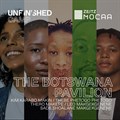
Illustrations of Mercedes Richards (left) and Asquith Xavier (right) by Trinidadian artist Esther Griffith. | Source: Supplied
The first iteration of the project, in collaboration with artists from Africa, North America and the Caribbean, will help to address the visual and written underrepresentation of several Black historical figures on Wikipedia and in media repository Wikimedia Commons.
The commissioned artists include Enam Bosokah from Ghana, Esther Griffith from Trinidad and Tobago and Bukhtawar Malik from the United States. Among the first Wikipedia articles that will feature the new illustrations are Marian Ewurama Addy, William Greaves, Rose Dieng-Kuntz, May Miller, Mercedes Richards, and Asquith Xavier. These portraits will be published throughout the month of February.
I spoke to Khanyi Mpumlwana, global creative director at the Wikimedia Foundation, to find out more about this project, its objectives and the role art plays in documenting history:
Briefly tell us about the Wiki Unseen project.
The Wikimedia Foundation, the global non-profit that operates Wikipedia, is launching Wiki Unseen. In this first phase of the project, we are collaborating with artists from Africa, America and the Caribbean.
The project is aimed at expanding the visual representation of black, indigenous, and people of color (Bipoc) in Wikimedia projects and advancing knowledge equity. Over the next few years, the Foundation will collaborate with volunteers and artists from around the world to redraw history, adding illustrations to biographies of those underrepresented on our projects.
How did the idea of this project come about?
The media ecosystem has a problem - the stories, experiences and contexts of Black people, people of colour and indigenous people are not fully represented in the history and stories that we tell.This bias is also reflected in Wikimedia projects because projects like Wikipedia rely on secondary sources - news, academic, research and articles - for their content.
As an example, of the 30+ articles in the African Royalty category on English Wikipedia, only three pages have imagery depicting those monarchs. The Wikimedia Foundation is working with global volunteers to close these gaps in order to achieve its vision of a world in which every human can share in the sum of all knowledge.
Wiki Unseen is part of this work.
What is the main objective of this project?
There are two main objectives for this initiative. The first to increase awareness of the bias and visual knowledge gaps in the histories of Black people, indigenous people and people of colour, and the need to fill these gaps on Wikimedia projects.
Secondly, to increase contributions, showing how artists and creatives can participate in knowledge creation by addressing its gaps.
How important is it for people - especially Black, indigenous, and people of colour - to know about their history and iconic historical figures?
Marcus Garvey famously wrote: “A people without knowledge of their past history, origin and culture is like a tree without roots”.
We aim to use Wiki Unseen as a means to make our own contribution to strengthen the historical narratives around Black people, indigenous people and people of colour. This campaign is an opportunity to grow the Wikipedia audience to include those who have historically and systemically been left out of knowledge production.
You could have opted for other mediums of expression to showcase Black historical figures. Why art?
Art has an integral role in world history. We felt that having these pages receive visual representation through art was important. By collaborating with artists, we are highlighting the critical role visual illustrators play in documenting history.
This should not end with Wiki Unseen but attract new players in this genre to help shape how the next generation will understand and see history.
What role does art play in influencing positive social change?
Research done by the Wikimedia Foundation shows that clicks on images occur in biographies of less well-known people. This means art has a crucial role to play to bring African history makers recognition. For as long as we have been sentient, communicating beings, art has been at the centre of how we create, shape and derive meaning.
We remember more of what we have seen through pictures and heard through sound than what we have read. The line “representation matters” has been reworked and expressed in a multitude of ways. In this instance, for this project, it means that by deliberately and consistently working to ensure that those who have long been left out of how we picture history have just as much representation as those who were commonly heralded. Thus, ensuring current and future generations understand their histories differently.
It’s about opening up all spheres of knowledge not just the bits that serve the interests of some groups. Art is a powerful tool that allows us to redraw the history that has shaped who we are.
How will Black artists featured in this project benefit from it?
For the inaugural Wiki Unseen, the artists who we have commissioned will get greater visibility around their work. Wikipedia is one of the top 10 most visited websites in the world. Through their work, we hope that as this initiative grows in importance and scale, more artists will be inspired to volunteer their time and effort to address the world’s knowledge gaps.
What are your thoughts on art in Africa?
As the global creative director of the Wikimedia Foundation, I have the privilege of working with creatives from across the world. What stands out about Africa is that we are a young continent, the art we produce is vibrant, engaging and tells the stories of our complexities, interconnectivities and social dynamics.
Do you have any other information to share about the project?
There will be many iterations and explorations of this work and we look forward to a future where this creates a generation of Wikipedia contributors who lend their talents to building better, more comprehensive knowledge resources for all.















































